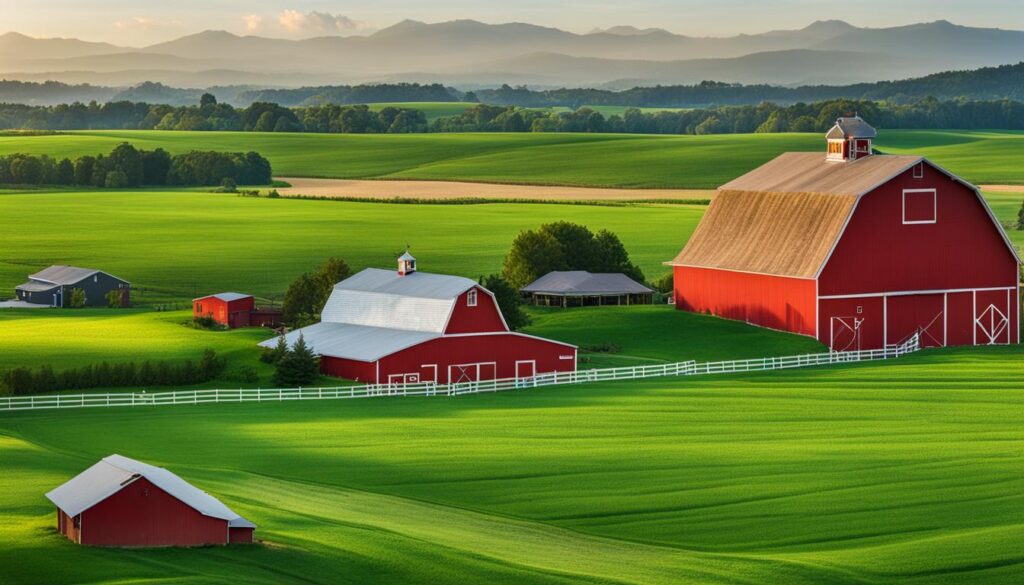Are you dreaming of owning your own home? With USDA Loans, that dream can become a reality. USDA Loans offer flexible credit standards, 100% financing, and 30-year or 15-year fixed-rate terms. Best of all, they do not require a down payment and have lower interest rates compared to conventional loans. If you’re looking for an affordable home loan option, USDA Loans could be the perfect solution for you.
Key Takeaways
- USDA Loans offer 100% financing and lower interest rates compared to conventional loans.
- These loans have flexible credit requirements, making them accessible to borrowers with less-than-perfect credit scores.
- USDA Loans are ideal for individuals or families with lower incomes who are looking to purchase a primary residence in a rural or suburban area.
- To be eligible for a USDA Loan, you must meet certain criteria such as income limits and purchasing a home in a designated rural area.
- Use a USDA Loan calculator to estimate your monthly mortgage payments and determine if this loan is the right fit for you.
Benefits of USDA Loans
USDA loans offer several benefits that can make them an appealing option for homebuyers. Here are some key advantages:
- No Down Payment Requirement: One of the most significant benefits of USDA loans is that they do not require a down payment. This means that qualified borrowers can finance 100% of the home’s purchase price, making homeownership more accessible.
- Lower Interest Rates: USDA loans typically offer lower interest rates compared to conventional loans. This can result in significant savings over the life of the loan.
- No Monthly Mortgage Insurance: Unlike many other loan programs, USDA loans do not require borrowers to pay monthly mortgage insurance. This can reduce the overall cost of the loan.
- Flexible Credit Requirements: USDA loans have more lenient credit requirements compared to conventional loans. Borrowers with lower credit scores may still be eligible for a USDA loan, making it a viable option for those who may not qualify for other loan programs.
It’s important to note that USDA loans have income limits and geographic restrictions. Borrowers must meet certain income requirements to be eligible for the loan, and the property must be located in a designated rural or suburban area. However, for those who meet the criteria, USDA loans can provide a range of benefits that make homeownership more attainable.

Table: Comparison of USDA Loans and Conventional Loans
| Loan Type | Down Payment Requirement | Interest Rates | Monthly Mortgage Insurance | Credit Requirements |
|---|---|---|---|---|
| USDA Loans | No down payment required | Lower interest rates | No monthly mortgage insurance | More flexible credit requirements |
| Conventional Loans | Typically require a down payment | Higher interest rates | May require monthly mortgage insurance | Stricter credit requirements |
As shown in the table above, USDA loans offer significant advantages over conventional loans, particularly in terms of down payment requirements, interest rates, and monthly mortgage insurance. These benefits can make USDA loans a favorable choice for eligible borrowers looking to purchase a home in a designated rural or suburban area.
USDA Loan Process
Applying for a USDA loan involves several steps to ensure a smooth and successful homebuying experience. Here is a breakdown of the USDA loan process:
- Check Eligibility: Before starting the application process, visit the USDA Income and Property Eligibility site to determine if the property you are interested in qualifies for a USDA loan.
- Pre-Qualification: To pre-qualify for a USDA loan, you must meet the income requirements and credit score standards. This step helps determine the loan amount you may be eligible for.
- Complete Application: Once you are pre-qualified, complete the USDA loan application. This requires providing personal and financial information, including income, employment history, assets, and liabilities.
- Submit Documentation: Along with the application, you will need to submit supporting documents such as pay stubs, bank statements, tax returns, and proof of identity.
- Underwriting: After submitting your application and documents, the lender will review and verify the information provided. This process involves assessing your creditworthiness, employment stability, and financial capacity to repay the loan.
- Loan Approval: If your application is approved, you will receive a loan commitment letter outlining the terms and conditions of the loan.
- Home Purchase: With the loan approved, you can proceed with purchasing your dream home. The loan funds will be disbursed to the seller, and you can move into your new property.
Remember, the USDA loan process may vary slightly depending on the lender and individual circumstances, so it’s important to consult with your chosen lender and seek their guidance throughout the process. By following these steps and providing accurate information and documentation, you can increase your chances of securing a USDA loan for the home of your dreams.
| Advantages | Considerations |
|---|---|
| No down payment requirement Lower interest rates compared to conventional loans Flexible credit requirements Fixed-rate terms of 30 years or 15 years | Available for homes in designated rural areas Income restrictions apply |
“Applying for a USDA loan is an excellent option for homebuyers looking to purchase a property in a designated rural area. The streamlined process and attractive loan terms make it an appealing choice for many individuals and families.”

USDA Loan Eligibility
If you’re considering a USDA loan, it’s important to understand the eligibility requirements. To qualify for a USDA loan, you must meet certain criteria set by the United States Department of Agriculture. These criteria include:
- Purchasing a primary residence in a designated rural or suburban area.
- Meeting the income limits set by the USDA for your area. These limits vary depending on the size of your household and the location of the property.
USDA loans are particularly beneficial for first-time homebuyers or those with limited down payment savings. Additionally, USDA loans are suitable for borrowers with less-than-perfect credit scores who may not qualify for conventional loans.
Income Limits
One of the key eligibility requirements for a USDA loan is meeting the income limits set by the USDA. These limits are based on the median income of your area and the size of your household. It’s important to note that income limits may vary depending on the location of the property.
By checking the USDA’s income eligibility guidelines, you can determine if your household income falls within the program limits. This will help you assess your eligibility for a USDA loan and plan your homebuying journey accordingly.
| Household Size | 1-4 Member Income Limit | 5+ Member Income Limit |
|---|---|---|
| 1 | $52,800 | $69,650 |
| 2 | $62,950 | $82,750 |
| 3 | $70,300 | $92,150 |
| 4 | $78,300 | $103,200 |
| 5+ | $86,900 | $114,650 |

It’s important to note that the income limits may be higher in areas with higher home prices, and lower in areas with lower home prices. It’s recommended to check the USDA’s income eligibility guidelines specific to your area to determine if you meet the requirements.
USDA Loan Requirements
Before applying for a USDA loan, it’s important to understand the specific requirements that borrowers must meet. These requirements ensure that the loan program is used for its intended purpose of promoting homeownership in rural and suburban areas. Here are the key USDA loan requirements you should be aware of:
Credit Score
USDA loans have a minimum credit score requirement of 640. This means that borrowers need to have a reasonably good credit history to be eligible for the loan. If your credit score is below 640, you may need to work on improving it before applying for a USDA loan. Additionally, having a higher credit score can potentially help you secure a better interest rate.
Debt-to-Income Ratio
The USDA sets a maximum debt-to-income ratio of 41% for borrowers. This ratio compares your total monthly debt payments to your gross monthly income. It’s important to keep your debt-to-income ratio within the USDA’s limits to demonstrate that you can comfortably afford the monthly mortgage payments along with your other financial obligations.
Bankruptcy
Borrowers who have experienced bankruptcy within the last two years may not be eligible for a USDA loan. If you have a bankruptcy on your record, it’s important to wait until the required waiting period has passed before applying for a USDA loan.
Property Requirements
There are certain property requirements that must be met for a USDA loan. The property must be located in an eligible rural or suburban area as defined by the USDA. Additionally, the property must be the borrower’s primary residence. It’s important to verify the eligibility of the property before applying for the loan.
Contractor Requirements
If you plan on using contractors for the construction or renovation of your home, they must meet certain criteria set by the USDA. This includes having the proper licensure and liability insurance. It’s important to ensure that your chosen contractors meet these requirements to ensure the smooth processing of your USDA loan application.

USDA Loan Limits
USDA loans have income limits based on the borrower’s area’s median income and the size of their family. These limits are intended to help moderate- and low-income families purchase and build homes. The maximum loan amount for USDA loans may not be sufficient for borrowers looking to purchase a higher-priced home. It’s important for borrowers to check if their income falls within the program limits based on household size and county.
USDA Loan Income Limits by Household Size
| Household Size | 1-4 Members | 5-8 Members |
|---|---|---|
| Income Limit | $90,300 | $119,200 |
As shown in the table above, the income limits for USDA loans vary based on the number of individuals in the household. For households with 1-4 members, the income limit is set at $90,300, while households with 5-8 members have a higher income limit of $119,200. It’s important for borrowers to ensure that their household income falls within these limits in order to be eligible for a USDA loan.
It’s worth noting that these income limits are subject to change and may vary based on the specific county or area. Borrowers should consult the USDA’s guidelines or speak with a loan specialist to determine the exact income limits for their desired location.
By setting income limits, USDA loans aim to assist families with lower incomes in achieving their homeownership goals. These loans provide an opportunity for individuals and families who may not qualify for conventional loans to secure financing for a home in a rural or suburban area.

USDA Loan Calculator
When considering a USDA loan, it’s important to know how much you can afford and what your monthly mortgage payments might look like. That’s where a USDA loan calculator comes in handy. By using this helpful tool, you can estimate your monthly payments based on factors such as the loan amount, interest rate, loan term, and property location.
The USDA loan calculator provides a simple and user-friendly interface, allowing you to input the necessary details to calculate your potential mortgage payments. This includes the loan amount you’re considering, the interest rate you may qualify for, and the length of the loan term. Additionally, you can enter the property location to accurately calculate property taxes and insurance costs.
Using a USDA loan calculator can give you a clear understanding of your financial obligations and help you determine if a USDA loan is the right choice for your homebuying needs. It can also help you compare different loan options and choose the one that works best for your budget.
So, before you make any decisions, take advantage of the USDA loan calculator to gain insight into your potential mortgage payments and make an informed choice about homeownership.
| Loan Amount | Interest Rate | Loan Term | Property Location | Monthly Mortgage Payment |
|---|---|---|---|---|
| $200,000 | 3.5% | 30 years | Rural | $898.09 |
| $250,000 | 3.0% | 15 years | Suburban | $1,726.70 |
| $300,000 | 4.0% | 30 years | Rural | $1,432.25 |

Finding USDA Loan Lenders
When it comes to finding USDA loan lenders, it’s essential to do your research and find the right lender who can provide you with the loan that best fits your needs. Not all lenders offer USDA loans, so it’s important to look for lenders who are approved to provide this type of financing. You can start by checking with your local banks and credit unions, as they may have experience working with USDA loans and can guide you through the process.
Another option is to search online for USDA loan lenders. Many lenders have websites where you can learn more about their loan programs and submit an application. It’s important to review the lender’s qualifications, experience, and customer reviews to ensure they are reputable and trustworthy.
Consulting with a knowledgeable loan specialist can also be beneficial. They can help you navigate the USDA loan process, answer your questions, and provide you with tailored mortgage solutions based on your unique financial situation. Loan specialists have expertise in USDA loans and can guide you through the application, underwriting, and closing processes.
Considerations When Choosing a USDA Loan Lender
- Approval: Look for lenders who are approved by the USDA to provide loans. This ensures they meet the necessary standards and can offer you the financing you need.
- Experience: Choose lenders with experience in USDA loans. They will have a better understanding of the requirements, documentation, and potential challenges that may arise throughout the process.
- Customer Service: Assess the lender’s customer service reputation. Read reviews and testimonials to determine if past borrowers were satisfied with their experience.
- Interest Rates and Fees: Compare interest rates and fees from different lenders to ensure you’re getting the most competitive terms. This can significantly impact the overall cost of your loan.
By taking the time to find the right USDA loan lender, you can increase your chances of obtaining favorable loan terms and successfully purchasing your dream home in a rural or suburban area.
| Lender | USDA Loan Experience | Interest Rates | Customer Reviews |
|---|---|---|---|
| XYZ Bank | 10 years | 3.25% | 4.5/5 |
| ABC Credit Union | 5 years | 3.15% | 4/5 |
| 123 Mortgage | 3 years | 3.35% | 4.2/5 |
Note: The table above is a sample representation and does not reflect current rates or available lenders. Please research and compare lenders based on current market conditions.

USDA Loans in Nebraska
The state of Nebraska offers several USDA loan programs to help residents achieve their dream of homeownership. Whether you’re looking to purchase a home in a rural area or a suburban neighborhood, USDA loans can provide the financing you need. These loan programs are designed to support low- and moderate-income families by offering competitive interest rates and flexible credit requirements.
USDA loans in Nebraska are available through the USDA Rural Development program. This program has been instrumental in helping thousands of families in the state become homeowners. It provides billions of dollars in home loans and contributes to the economic growth and stability of rural communities in Nebraska.
To qualify for USDA loans in Nebraska, you need to meet certain eligibility requirements. First, the property you’re purchasing must be located in an eligible rural area. The USDA has designated specific areas as eligible for these loans to support the development of rural communities. Second, your income must fall within the USDA-established limits for your area and household size. These limits are based on the median income in your county and are designed to assist low- to moderate-income families in accessing homeownership opportunities.
To find out if you’re eligible for USDA loans in Nebraska and to learn more about the loan programs available in the state, you can contact your local USDA Rural Development office or visit the agency’s website. Their knowledgeable staff can guide you through the application process and provide you with the information you need to make an informed decision about homeownership.

Economic Impact of USDA Loans
USDA loans not only provide safe homes for families but also generate significant economic activity in various industries. The construction sector experiences a boost as new homes are built, creating job opportunities for contractors, builders, and construction workers. Additionally, the real estate market benefits from increased sales and property values in rural areas, attracting businesses and stimulating economic growth.
Moreover, USDA loans contribute to the stability of local communities by creating a strong tax base. The additional revenue generated from property taxes helps fund public services such as schools, hospitals, and infrastructure improvements. This investment in community development contributes to the overall well-being and quality of life for residents.
“USDA loans provide a foundation for economic growth in rural areas, helping to revitalize and strengthen local economies.” – USDA Representative
Furthermore, USDA loans play a significant role in reducing energy costs and promoting sustainability. By enabling families to live closer to their workplaces, USDA loans help minimize commuting expenses and reduce carbon emissions. This not only benefits individual households but also contributes to the broader environmental goals of creating a greener future.

Impact on the American Economy
The economic impact of USDA loans extends beyond individual communities and has a positive effect on the American economy as a whole. The availability of affordable housing in rural areas attracts businesses, creating job opportunities and contributing to economic resilience. Additionally, investments in rural communities through USDA loans support the agricultural industry, which plays a crucial role in the nation’s food security and economic stability.
President Obama’s Plan for Rural America
Under President Obama’s leadership, a comprehensive plan was implemented to uplift and support rural America. This plan involved significant investments in various sectors, including housing, community facilities, businesses, and infrastructure. The aim was to empower rural communities, strengthen their economies, and revitalize small towns across the country. The United States Department of Agriculture (USDA) played a crucial role in implementing these initiatives, channeling funds and resources to support rural development.
The USDA’s investments in rural communities had a profound impact on the economic growth and sustainability of these areas. By providing funding for housing projects, the USDA helped families achieve homeownership and created safe and affordable housing options. This not only improved the living conditions of rural residents but also generated economic activity in the construction industry and supported local realty businesses.
The investments made through President Obama’s plan also focused on developing community facilities such as schools, healthcare centers, and public spaces. These facilities became essential hubs for rural residents, providing access to quality education, healthcare services, and recreational opportunities. The construction and maintenance of these facilities created jobs and stimulated the local economy.
Additionally, the plan aimed to boost businesses in rural America by providing financial assistance and access to capital. This allowed entrepreneurs and small business owners to expand their operations, create jobs, and contribute to the overall economic growth of their communities. By investing in infrastructure development, such as roads, bridges, and broadband connectivity, the plan improved the transportation and communication networks in rural areas, making them more attractive for businesses to establish and thrive.
President Obama’s plan for rural America resulted in historic investments that empowered rural communities, strengthened their economies, and revitalized small towns.
The USDA’s Role in Rural Development
The USDA played a pivotal role in implementing President Obama’s plan for rural America. Through its various programs and initiatives, the USDA provided financial assistance, technical support, and resources to ensure the success of rural development projects. The agency worked closely with local governments, community organizations, and stakeholders to identify and address the specific needs of rural communities.
By aligning its efforts with the rural way of life and the values that underpin it, the USDA has contributed to the overall strength of the American economy. The investments made through President Obama’s plan have had lasting effects, creating opportunities for homeownership, supporting local businesses, and improving the quality of life in rural America.
| Investment Areas | Benefits |
|---|---|
| Housing | Safe and affordable homes, economic activity in construction industry |
| Community Facilities | Access to quality education, healthcare, and public spaces, job creation |
| Business Development | Financial assistance, job creation, economic growth |
| Infrastructure | Improved transportation and communication networks, increased business opportunities |
Conclusion
USDA loans offer a wonderful opportunity for you to purchase your dream home without the burden of a down payment and with lower interest rates compared to conventional loans. These loans have flexible credit requirements, making them an ideal choice for borrowers with lower credit scores. By meeting the eligibility requirements and completing the application process, you can take advantage of the benefits provided by USDA loans.
With USDA loans, you can enjoy the benefits of homeownership in rural and suburban areas, supporting the rural way of life and contributing to the overall strength of the American economy. These loans not only provide safe homes for families but also generate economic activity in various industries, helping create a strong tax base and attracting businesses to your community. By choosing a USDA loan, you are investing in your future and the future of your community.
So, if you are looking to become a homeowner and want to explore the benefits of USDA loans, take the time to research and find approved USDA loan lenders. With their expertise and guidance, you can navigate the loan process smoothly, ensuring a successful home purchase. Don’t miss out on the opportunity to achieve your homeownership dreams with USDA loans and enjoy the many benefits they have to offer.
FAQ
What are the benefits of USDA loans?
USDA loans offer no down payment requirement, lower interest rates, and no monthly mortgage insurance. They also have flexible credit requirements and are a good option for borrowers with lower credit scores.
What is the process for getting a USDA loan?
To get a USDA loan, you need to check if the property qualifies, pre-qualify for the loan, complete the USDA loan application, provide necessary documentation, and go through the underwriting process.
Who is eligible for a USDA loan?
To be eligible for a USDA loan, you need to purchase a primary residence in a designated rural or suburban area, have a household income below the USDA-established limits, and meet certain credit score and debt-to-income ratio requirements.
What are the requirements for USDA loans?
USDA loans have requirements such as a minimum credit score of 640, a debt-to-income ratio of no more than 41%, property location in an eligible rural area, and the property being the borrower’s primary residence.
Are there income limits for USDA loans?
Yes, USDA loans have income limits based on the borrower’s area’s median income and the size of their family. Borrowers need to check if their income falls within the program limits to be eligible.
How can I estimate my monthly mortgage payments with a USDA loan?
You can use a USDA loan calculator to estimate your monthly mortgage payments. By inputting details such as the loan amount, interest rate, loan term, and property location, you can get an idea of how much you can afford.
Where can I find USDA loan lenders?
To find USDA loan lenders, you can start by checking with your local banks and credit unions. It’s also helpful to search online for USDA loan lenders or consult with a knowledgeable loan specialist.
How does USDA loans impact rural communities in Nebraska?
USDA loans have been successful in helping rural Nebraska residents achieve homeownership and have generated economic activity in construction, realty, banking, and other related industries. These loans support the rural way of life and contribute to the overall strength of the American economy.
What was President Obama’s plan for rural America?
President Obama’s plan for rural America resulted in historic investments in housing, community facilities, businesses, and infrastructure. These investments have empowered rural America to strengthen its economy and small towns, aligning with the rural way of life and contributing to the backbone of American values.
